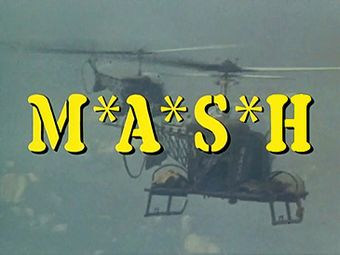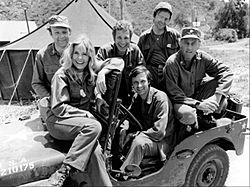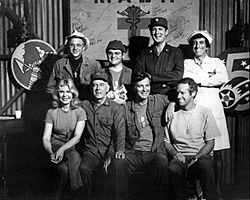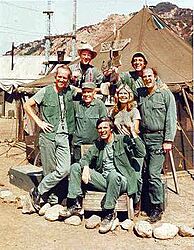M*A*S*H (TV series) facts for kids
Quick facts for kids M*A*S*H |
|
|---|---|
 |
|
| Created by | H. Richard Hornberger |
| Developed by | Larry Gelbart |
| Starring | Alan Alda Loretta Swit Jamie Farr William Christopher Wayne Rogers (1972–75) McLean Stevenson (1972–75) Larry Linville (1972–77) Gary Burghoff (1972–79) Harry Morgan (1975–83) Mike Farrell (1975–83) David Ogden Stiers (1977-83) |
| Theme music composer | Johnny Mandel (written for the film) |
| Country of origin | United States |
| No. of seasons | 11 |
| No. of episodes | 251 (list of episodes) |
| Production | |
| Production location(s) | Los Angeles County, California (Century City and the Malibu Creek area) |
| Camera setup | Single camera |
| Running time | 24–25 minutes (per episode) |
| Production company(s) | 20th Century Fox Television |
| Release | |
| Original network | CBS |
| Original release | September 17, 1972 – February 28, 1983 |
| Chronology | |
| Followed by | AfterMASH W*A*L*T*E*R |
M*A*S*H (an acronym for Mobile Army Surgical Hospital) is an American war comedy drama television series that aired on CBS from September 17, 1972, to February 28, 1983. It was developed by Larry Gelbart as the first original spin-off series adapted from the 1970 feature film M*A*S*H, which, in turn, was based on Richard Hooker's 1968 novel MASH: A Novel About Three Army Doctors. The series, which was produced with 20th Century Fox Television for CBS, follows a team of doctors and support staff stationed at the "4077th Mobile Army Surgical Hospital" in Uijeongbu, South Korea, during the Korean War (1950–53).
The ensemble cast originally featured Alan Alda and Wayne Rogers as surgeons Benjamin "Hawkeye" Pierce and "Trapper" John McIntyre, respectively, as the protagonists of the show; joined by Larry Linville as surgeon Frank Burns, Loretta Swit as head nurse Margaret "Hot Lips" Houlihan, McLean Stevenson as company commander Henry Blake, Gary Burghoff as company clerk Walter "Radar" O'Reilly, Jamie Farr as orderly Maxwell Klinger, and William Christopher as the chaplain, Father John Mulcahy. Over the run of the show, several members of the main cast were replaced: Wayne Rogers was replaced by Mike Farrell as B. J. Hunnicutt, McLean Stevenson was replaced by Harry Morgan as Sherman Potter, Larry Linville was replaced by David Ogden Stiers as Charles Emerson Winchester III, and, when Gary Burghoff left the show, the Maxwell Klinger character moved into the company clerk role. Longtime supporting cast members included Kellye Nakahara, Jeff Maxwell, Allan Arbus, and Edward Winter.
The series varied in style and tone – including broad comedy and tragic drama – which can be attributed to fluctuating writing staff over the life of the show and the variety of sources contributing to the stories, such as actor Alan Alda and surgeons who served in the Korean War.
The show was created after an attempt to film the original book's sequel, M*A*S*H Goes to Maine, failed. The television series is the best-known of the M*A*S*H works and one of the highest-rated shows in U.S. television history. Its final episode, "Goodbye, Farewell and Amen", was the most-watched television broadcast in American history from 1983 until 2010, and it remains both the most-watched finale of any television series and the most-watched episode of a scripted series.
Main cast
-
Publicity photo of the cast of M*A*S*H shot just prior to the production of Season 2, 1974 (clockwise from left): Loretta Swit, Larry Linville, Wayne Rogers, Gary Burghoff, McLean Stevenson, and Alan Alda
-
The cast of M*A*S*H from Season 6, 1977 (clockwise from left): William Christopher, Gary Burghoff, David Ogden Stiers, Jamie Farr, Mike Farrell, Alan Alda, Harry Morgan, Loretta Swit.
-
The cast of M*A*S*H from season 8 onward (clockwise from left): Mike Farrell, William Christopher, Jamie Farr, David Ogden Stiers, Loretta Swit, Alan Alda, and Harry Morgan
Through changes of personnel M*A*S*H maintained a relatively constant ensemble cast, with four characters – Hawkeye, Father Mulcahy, Margaret Houlihan, and Maxwell Klinger – on the show for all 11 seasons. Several other main characters departed or joined the program during its run, and numerous guest actors and recurring characters were used. The writers found creating so many names difficult, and used names from elsewhere; for example, characters on the seventh season were named after the 1978 Los Angeles Dodgers.
| Character | Actor/actress | Rank | Role | Appearances |
|---|---|---|---|---|
| Benjamin Franklin "Hawkeye" Pierce | Alan Alda | Captain | Chief surgeon | 256 |
| Margaret "Hot Lips" Houlihan (Penobscott) | Loretta Swit | Major | Head Nurse | 239 |
| Maxwell Q. Klinger (recurring seasons 1–3, regular 4–11) |
Jamie Farr | Corporal, later Sergeant |
Combat Medic, later Company Clerk |
217 |
| Father John Patrick Francis Mulcahy (recurring seasons 1–4, regular 5–11) |
George Morgan (pilot episode), replaced by William Christopher |
First Lieutenant, later Captain |
Chaplain | 213 |
| Trapper John McIntyre (seasons 1–3) |
Wayne Rogers | Captain | Surgeon | 72 |
| Henry Blake (seasons 1–3) |
McLean Stevenson | Lieutenant Colonel | Commanding officer, Surgeon |
70 |
| Frank Burns (seasons 1–5) |
Larry Linville | Major, later Lieutenant Colonel |
Surgeon | 118 |
| Walter Eugene "Radar" O'Reilly (seasons 1–8) |
Gary Burghoff | Corporal, briefly Second Lieutenant |
Company clerk, bugler |
156 |
| B.J. Hunnicutt (replaced Trapper; seasons 4–11) |
Mike Farrell | Captain | Surgeon | 183 |
| Sherman T. Potter (replaced Henry Blake; seasons 4–11) |
Harry Morgan | Colonel | Commanding Officer (after Lt. Col. Blake), Surgeon |
182 |
| Charles Emerson Winchester III (replaced Frank Burns; seasons 6–11) |
David Ogden Stiers | Major | Surgeon | 133 |
"Goodbye, Farewell, and Amen"
"Goodbye, Farewell, and Amen" is the series finale. It was aired on February 28, 1983, and is two and a half hours long. Nearly 106 million Americans watched it, which was 77% of the people watching TV at the time. It is the most watched episode of any show in American history.
Images for kids
-
The operating room set on display in the National Museum of American History as part of the "MASH: Binding Up the Wounds" exhibit in 1983.
See also
 In Spanish: MASH (serie de televisión) para niños
In Spanish: MASH (serie de televisión) para niños






